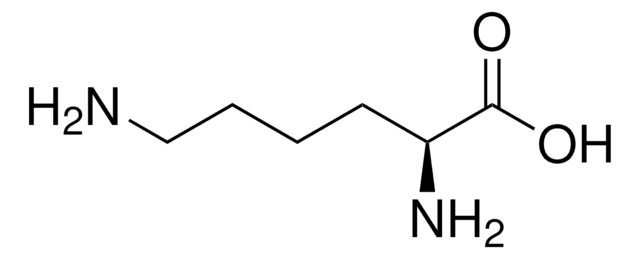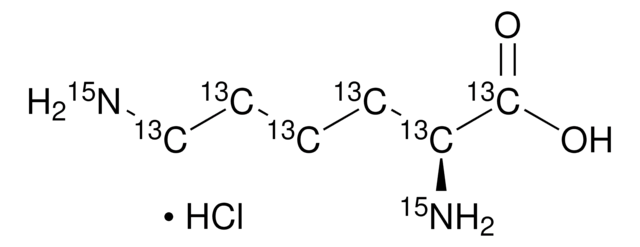L9037
L-Lysine monohydrate
98.5-101.5% dry basis, suitable for cell culture, BioReagent, non-animal source
Synonym(s):
L-Lysine hydrate (1:1), Lysine monohydrate
About This Item
Recommended Products
product name
L-Lysine monohydrate, BioReagent, suitable for cell culture, from non-animal source
biological source
non-animal source
product line
BioReagent
Assay
98.5-101.5% dry basis
form
crystalline powder
technique(s)
cell culture | mammalian: suitable
impurities
endotoxin, tested
color
white
mp
215 °C
solubility
H2O: soluble
SMILES string
[H]O[H].NCCCC[C@H](N)C(O)=O
InChI
1S/C6H14N2O2.H2O/c7-4-2-1-3-5(8)6(9)10;/h5H,1-4,7-8H2,(H,9,10);1H2/t5-;/m0./s1
InChI key
HZRUTVAFDWTKGD-JEDNCBNOSA-N
Looking for similar products? Visit Product Comparison Guide
Related Categories
General description
Application
- SILAC (stable isotope labeling by amino acids in cell culture) method
- the complete synthetic (C) medium for positive selection screening of yeast cells
- the growth medium for cells
Biochem/physiol Actions
Storage Class Code
11 - Combustible Solids
WGK
WGK 1
Flash Point(F)
Not applicable
Flash Point(C)
Not applicable
Personal Protective Equipment
Certificates of Analysis (COA)
Search for Certificates of Analysis (COA) by entering the products Lot/Batch Number. Lot and Batch Numbers can be found on a product’s label following the words ‘Lot’ or ‘Batch’.
Already Own This Product?
Find documentation for the products that you have recently purchased in the Document Library.
Customers Also Viewed
Our team of scientists has experience in all areas of research including Life Science, Material Science, Chemical Synthesis, Chromatography, Analytical and many others.
Contact Technical Service








